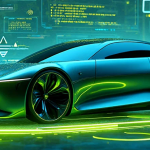If software is the new engine, then the user experience (UX) is the horsepower.
What captivated IAA 2025 visitors was the concept of the vehicle as an extension of one’s digital life, a third living space. Software drives this differentiation through:
Hyper-Personalization: Imagine a car that automatically sets a calming mood, adjusts performance, and reroutes navigation based on your work calendar or current stress levels. This requires a complex, integrated software profile that manages and syncs your digital identity, making the car a uniquely personal space.
Microtransactions: Software enables new business models. Customers can activate micro features like enhanced driver assistance, a performance boost, or a new Halloween theme for a limited time via a simple microtransaction. This turns the car into a continuous source of revenue and customer value, extending the relationship far past the initial sale.
AI as the Co-Pilot: The AI systems showcased were proactive AI pilots, not rigid voice commands. They use complex machine learning to anticipate your needs and manage tasks in real time. In a sea of LLMs, the automaker whose AI is genuinely intelligent, intuitive, and trustworthy will capture the market.
The Time Clash: When a Five-Year Cycle Meets a Five-Week Update
This digital transformation in the automotive industry brings an immense challenge: the fundamental clash of timeframes.
For generations, the auto industry operated on a five-year refresh cycle. Designing a new car and its hardware took half a decade, and once on the road, its features were static. This was the natural pace of the industrial age.
The world of software, however, operates on a five-week update cycle. Apps and operating systems receive new features and security patches constantly. If an automaker waits five years to launch a new feature, their digital offering will be instantly obsolete compared to consumer expectations.
This speed gap creates an immense business risk. The shift to the Software-Defined Vehicle is the only way to bridge this chasm. By decoupling digital features from the rigid hardware timeframe, the car’s digital life can accelerate to the speed of the consumer, ensuring the vehicle remains fresh and competitive throughout its entire lifespan.
The Integration Imperative: Why Tech Integrators Are the New Co-Pilots
The tech giants at IAA 2025 highlighted a crucial reality: they provide the powerful building blocks, the cloud infrastructure (AWS) and the underlying operating systems (Google), but they don’t provide the personalized, branded experience. That requires a specialized architect and systems integrator.
The ultimate winners in the SDV era will be those who master integration. At Globant, we have been helping the industry solve this challenge from the shopping experience to a new vehicle launch.
The new challenge for automakers is not just how to build a part, but how to seamlessly weave together software from their own teams, tech giant platforms, and third-party services into a unique, branded product. This requires a new type of partner, a global system integrator.
Systems integrators are essential because they:
- Unlock Branded Experience: An integrator ensures that the driver-facing UX, the look, feel, and unique features, is purely and authentically the automaker’s brand, preventing their identity from being subsumed by the platform provider.
- Manage Complexity: They handle the staggering complexity of integrating vast cloud architectures, AI systems, and security protocols, bridging the gap between the speed of software development and the high safety standards of the auto industry.
- Accelerate the Transformation: By providing agile teams and established methodologies, integrators help automakers shed their slower, hardware-centric operations and adopt the continuous deployment model necessary to survive the “Time Clash.”
The Path Forward for Automotive Leaders
IAA Mobility 2025 was the final signal that the old automotive paradigm is over. Software is now solidly in the driver’s seat.
The success story of the next decade will belong to the automakers who:
- Define their digital destiny and control the core customer experience.
- Embrace the speed of software to ensure their vehicles constantly improve through updates.
- Partner strategically with expert tech integrators to master the complex automotive software development architecture.
- Be transparent with customers, as charging for enabling hardware features that are already baked into the cost of the vehicle can break trust.
The competition is no longer between the quality of the engines, but the quality of the software architecture that delivers a superior, continually evolving user experience.
IAA Mobility 2025 didn’t just showcase new cars; it showcased a new era. Software has taken the wheel, and the companies that master this digital domain will be the ones that own the future of mobility.
At Globant, we’re harnessing the full power of our digital capabilities to accelerate automotive connectivity and drive the next era of intelligent, connected mobility. Click here to learn more about how our Automotive Studio is redefining the future of the industry.




